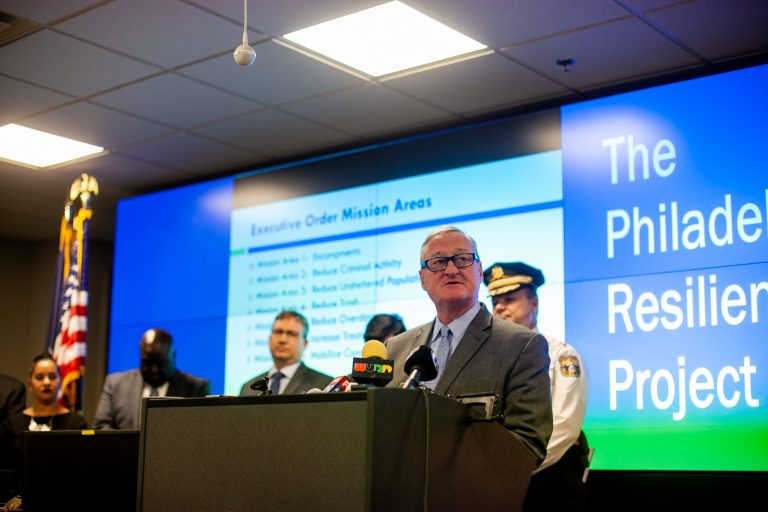Philly unveils emergency response to opioid ‘disaster’ in Kensington
The city calls its new emergency-oriented approach “The Philadelphia Resilience Project,” acknowledging the deaths and suffering caused by addiction go beyond Kensington.

Mayor Jim Kenney and city officials speak at a press conference on the city's emergency response to combat the opiod epidemic in Kensington and surrounding neighborhoods. (Brad Larrison for WHYY)
Philadelphia officials Thursday announced the initial goals of Mayor Jim Kenney’s recent disaster declaration to address the devastating effects of the city’s opioid crisis, including plans to clear two remaining homeless encampments in the Kensington neighborhood.
Although the city’s response will focus on the Kensington epicenter of the crisis, officials made the announcement at the new base of operations for coordinating the emergency response — the Office of Emergency Management’s operations center just outside Center City.
It’s a “mission-control” type space where officials usually gather to respond to everything from crippling snowstorms to post-Super Bowl mayhem. But since Kenney’s disaster declaration two weeks ago, it’s become the home base for representatives from 35 city offices and agencies putting their heads together to tackle problems of homelessness, rampant overdoses, and the chaos of open-air drug dealing and using.
“It’s become apparent that our current approach is not working,” Kenney said. “Addiction has led to prostitution on our streets. Schoolyards and parks are littered with trash, human waste, and used syringes.”
The city is calling its new emergency-oriented approach “The Philadelphia Resilience Project,” acknowledging that the deaths and suffering caused by addiction go beyond Kensington.
Although the main operations center isn’t located in Kensington, Deputy Managing Director Brian Abernathy said the city planned to open an outpost of some kind in that neighborhood where officials organizing the response can have a more local presence. That may be necessary to win over residents who see the city’s efforts as no more than a gesture.
“Not just city government, but the city leadership — civic infrastructure — has failed Kensington,” Abernathy said. “So they have every right to be skeptical. But we’re committed to making change here.”
He added that the Office of Emergency Management’s center was equipped with tools and technology that would allow the city to react quickly to new challenges.
Setting priorities
One of the top priorities is to clear homeless encampments along Lehigh Avenue that are home to 150 people struggling with addiction. That will begin with clearing one on Frankford Avenue by Nov. 16.
The city has already posted signs there giving encampment residents 30 days’ notice to leave, said Liz Hersh, director of the Office of Homeless Services.
Hersh said the city will follow an enhanced version of the plan it used to clear two other encampments in May, offering immediate access to treatment and shelter to those living in the Frankford Avenue underpass below the Conrail tracks. Forty shelter beds have been dedicated for them at a low-barrier respite nearby.
“There’s a bed for everybody who wants to come in,” Hersh said.
That approach yielded results for many people living at two other encampments that were cleared in May, she said.
“We’re seeing people get employed,” she said. “We’re seeing people reunite with family. We’re seeing people move into permanent housing options.”
Hersh said the city will also work to open another navigation center for homeless services with additional beds to serve the increasing need as winter approaches. In the past year, the street homeless population in Kensington has nearly tripled, numbering more than 700.
Residents will be able to track the progress of the emergency response on a website to be updated weekly, officials said.
WHYY is your source for fact-based, in-depth journalism and information. As a nonprofit organization, we rely on financial support from readers like you. Please give today.




